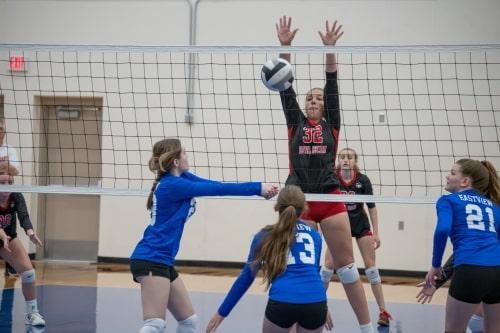Volleyball in Schools and Colleges

Volleyball in Schools and Colleges: Introduction and Development in Educational Institutions
Volleyball has long been a popular sport across the world, known for its fast pace, teamwork and minimal equipment requirements. Introduced in 1895 by William G. Morgan in Holyoke, Massachusetts, volleyball was designed as a game that combined elements of basketball, baseball, tennis and handball.
Originally called “mintonette,” volleyball was created to be a less physically demanding alternative to basketball, providing a dynamic and enjoyable recreational sport for adults.
Over time, the simplicity and adaptability of volleyball made it an excellent candidate for inclusion in schools and colleges. Educational institutions adopted volleyball as part of their physical education (PE) programs, recognizing the benefits it offers in terms of fitness, teamwork and personal development.
Today, volleyball is a core part of sports curricula in schools and colleges worldwide, fostering both competitive spirit and physical well being among students.
The Early Introduction of Volleyball in Schools
Volleyball began making its way into school settings in the early 20th century, shortly after its invention. As it spread to YMCA centers and community clubs, schools recognized its potential for physical education. By the 1920s, volleyball was being taught in American schools due to its simplicity and the low cost of equipment—requiring only a net, a ball and a flat playing surface.
PE teachers found that volleyball was accessible to all students regardless of their fitness levels, offering a versatile sport that was both fun and beneficial. Unlike sports that demanded significant physical contact or expensive gear, volleyball encouraged students to engage in physical activity while learning essential life skills such as teamwork, communication and strategy.
The National Federation of State High School Associations (NFHS) played a key role in standardizing volleyball for high schools, establishing rules, guidelines and competitive structures to encourage organized play. By the mid 20th century, volleyball had become a staple in PE programs across the United States and gradually spread to schools in other parts of the world.
Volleyball in Colleges and Universities
In addition to being part of school level PE programs, volleyball quickly found its place in colleges and universities. The sport’s adaptability allowed for both recreational and competitive play, making it a suitable activity for intramural sports programs. College students enjoyed volleyball for its balance of physical challenge and social engagement.
The establishment of official collegiate volleyball leagues and tournaments helped the sport grow in popularity. The National Collegiate Athletic Association (NCAA) introduced women’s volleyball as a championship sport in 1981, further promoting volleyball in higher education.
This inclusion not only increased opportunities for female athletes but also highlighted the importance of volleyball in fostering gender equality in sports.
Today, thousands of colleges in the United States and beyond have men’s and women’s volleyball teams, with scholarships available for talented athletes. College volleyball competitions, such as the NCAA Volleyball Championship and regional tournaments, have drawn significant attention, showcasing the high level of skill and athleticism present in collegiate volleyball.
Why Volleyball is Ideal for Educational Institutions
Volleyball’s enduring popularity in schools and colleges can be attributed to several key factors:
Physical Fitness: Volleyball is an excellent full body workout. The sport enhances cardiovascular health, strengthens muscles, improves coordination and increases agility. Playing volleyball helps students develop better reflexes and hand-eye coordination, which are essential for overall physical development.
Teamwork and Communication: Successful volleyball play requires clear communication and coordination among team members. Students learn to rely on each other, develop trust and strategize together. These skills are transferable to many areas of life, including academic group projects and future workplaces.
Accessibility: Volleyball is relatively inexpensive compared to other sports. Schools and colleges need only a net, a ball and a gymnasium or outdoor space. This affordability makes it accessible even to institutions with limited sports budgets.
Inclusivity: Volleyball accommodates players of different skill levels and physical abilities. Co-ed teams and mixed ability games are common, promoting inclusivity and equal participation. Adaptive versions of volleyball, such as sitting volleyball, ensure that students with physical disabilities can also enjoy the sport.
Mental Health Benefits: Engaging in physical activities like volleyball can reduce stress, improve mood and boost self esteem. The social interaction and team environment of volleyball help students form connections, which is particularly important for mental well being.
The Evolution of Volleyball Programs
Over the decades, volleyball programs in educational institutions have evolved significantly. In the early days, volleyball was primarily a recreational activity in PE classes. However, as interest grew, schools and colleges began forming competitive teams and participating in regional and national tournaments.
Today, many schools have well structured volleyball programs, including:
PE Classes: Volleyball remains a standard part of PE curricula, where students learn basic skills, rules and strategies.
Intramural Leagues: Many schools and colleges offer intramural leagues, allowing students to play volleyball recreationally while developing social bonds.
Varsity and Junior Varsity Teams: Competitive volleyball teams provide student athletes with opportunities to hone their skills and compete at higher levels.
Coaching and Development: Professional coaches help students develop their abilities, offering structured training sessions that emphasize both skill development and character building.
Youth Volleyball Programs: Some educational institutions collaborate with local volleyball clubs to offer youth development programs, ensuring that students are introduced to the sport at an early age.
Volleyball in a Global Context
While volleyball was born in the United States, its adoption in schools and colleges has become a global phenomenon. Countries like Brazil, Japan, Italy and Russia have integrated volleyball into their school systems, emphasizing the sport’s role in physical education.
International programs like the Fédération Internationale de Volleyball (FIVB) support grassroots development, ensuring that volleyball continues to thrive in educational settings worldwide.
The rise of beach volleyball, an Olympic sport since 1996, has also expanded the scope of volleyball in schools and colleges. Many institutions now offer beach volleyball programs, providing students with a variation of the game that emphasizes outdoor play and adaptability.
Conclusion
Volleyball’s journey from a recreational activity to a mainstream sport in schools and colleges highlights its versatility, accessibility and numerous benefits. The sport promotes physical fitness, teamwork, communication and inclusivity, making it an ideal addition to educational programs.
As schools and colleges continue to recognize the value of volleyball, the sport will remain a vital part of physical education, nurturing the next generation of athletes and well rounded individuals.


